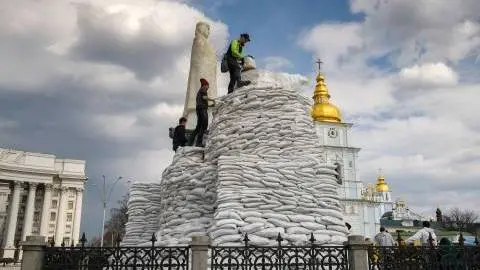ECB under pressure with inflation set to stay high
The Ukraine war has created another supply shock on top of an already high inflation rate. That causes second-round effects to become an even bigger risk to the short-term inflation outlook. For the medium-term, demand effects are likely to dampen the inflation outlook somewhat
Multiple supply shocks due to the pandemic pushed the headline inflation rate in the eurozone to 5.9% year-on-year in February. The war in Ukraine is now adding to these pressures, both in terms of levels and duration. In this note, we describe the different factors through which current developments will push up inflation further and look at the medium-term impact and the response from the European Central Bank (ECB).
Energy and food will cause a further spike in inflation
Inflation has been increasing mostly on energy prices in recent months and the war has caused a further jump in prices. March will see another increase in energy inflation and the months ahead will still be boosted by serious base effects. While many scenarios are imaginable at this point, futures do still point to modest declines in prices from current levels, which should result in a slow downward impact on the inflation rate. But still, energy inflation which was expected to trend down from late last year already has become a key driver of the higher for 2022 narrative. Forecasting based on current oil and gas futures suggests a contribution of energy to headline inflation of 2.7%. Projecting out using current spot prices would lead to an even higher contribution of 3.5%. Food prices add to this as global food prices are soaring on the back of high transport costs and failed harvests. For March and April, we already expect food inflation to add around 1ppt to headline inflation and it could well be that this increases further on the back of the war given the key position of Ukraine and Russia in the global food supply.
Core inflation also set to trend higher due to supply chain problems and second-round effects
Core inflation has also been running up. Goods inflation rose markedly in January as supply chain problems caused producer prices to soar, which have been priced through to the consumer. While supply chain problems had been abating since November and input shortages were dropping, they have recently reared their head again. The war in Ukraine and new lockdowns in China are adding to supply chain disruptions again, which could keep pressure on consumer goods prices elevated for longer than we initially expected.
On top of that, second-round effects from high energy prices will play into core inflation. That is not just the case for goods, but also services. Services prices have also been trending higher, mainly thanks to the reopening of economies now that the pandemic is in a less restrictive phase. Prices had been growing at about 1.5% in the years leading up to the pandemic, and what we see is that the second half of 2021 saw a catch-up to this trend after which it settled at the pre-crisis trend again. This suggests that we shouldn’t expect too much from the reopening inflation effect from here on, especially as real wages are being squeezed at the moment. That does not mean that there won’t be a further increase in services inflation from here on though. While reopening effects have faded, second-round effects from higher energy prices and in some service sectors from wages are set to be priced through.
Higher core inflation is not just driven by second-round effects from high energy prices
Inflationary in the short-run, deflationary in the medium-term?
The question is what effects on inflation from current developments will be dominant in the medium-term. Supply factors have been driving eurozone inflation to record highs, but with real wage growth at a multiple decade low, a marked economic slowdown or even recession would reduce expectations of demand-side inflation for the medium term. In fact, our expectations that wage growth will accelerate significantly this year and in 2023 have clearly come under pressure. We do still expect wage growth to trend higher as inflation is a dominant driver of wages which can even drive up wage growth during a recession – look at 2008 for example. However, chances are increasing that companies’ profit margins will come under significant pressure, which is set to lead to a lower peak in wage growth than previously expected.
For the ECB, this additional inflationary pressure will complicate things even further. Even if headline inflation hits double-digit levels, there is very little the ECB could do to bring imminent relief. Even worse, in a stagflationary scenario, too aggressive tightening could be counterproductive and undermine an increasingly fragile economic recovery. Therefore, we expect the ECB to continue ending its unconventional measures without engaging in a rate hike cycle like the US Federal Reserve. The ECB will focus on inflation expectations. If these expectations remain anchored, we will only see an end to net asset purchases and an end to the era of negative deposit rates by early 2023 at the latest. Only if inflation expectations threaten to de-anchor significantly could we see the ECB feeling urged to send a strong signal stressing its inflation fighter credibility. In such a scenario, the ECB might opt for more aggressive rate hikes; always knowing that downside risks to the economic outlook are increasing and surging government debt makes it harder for some eurozone countries to stomach significantly higher rates.
This publication has been prepared by ING solely for information purposes irrespective of a particular user's means, financial situation or investment objectives. The information does not constitute investment recommendation, and nor is it investment, legal or tax advice or an offer or solicitation to purchase or sell any financial instrument. Read more
Download
Download article
31 March 2022
ING Monthly: There’s nothing normal about the global economy This bundle contains 17 Articles
